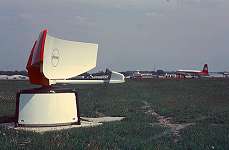ACR 430
Description of the radar set, tactical-technical characteristics

Figure 1: ACR430 in Bournemouth (England), © 1980 John Faulkner

| Specifications | |
|---|---|
| frequency: | 9 320 and 9 460 MHz
( X-Band) |
| pulse repetition time (PRT): | |
| pulse repetition frequency (PRF): | 2 kHz or 1 kHz |
| pulsewidth (τ): | 0.2 or 0.5 µs |
| receive time: | |
| dead time: | |
| peak power: | 2×55 kW |
| average power: | 110 W |
| instrumented range: | 32 NM (≙ 60 km) |
| range resolution: | 100 m |
| accuracy: | ±1% |
| beamwidth: | 0.55° |
| hits per scan: | |
| antenna rotation: | 20 or 40 rpm |
| MTBCF: | |
| MTTR: | |
ACR 430
The ACR430 (Abbr. of Airfield Control Radar) was an X-Band airfield control radar. It was designed between the 1950s and the mid 1960s as a replacement for the older Type 424 radar to meet the requirements of air surveillance control. The ACR430 radar employs a two-beam aerial system (high Fan-beam und low Pencil beam), two transmitters and receivers and two operational displays. It used fixed circular polarisation to reduce the effects of rain clutter.
Source:
- Plessey ACR430 Airfield Control Radar, RSL 1986, Issue 2 June 1977 (online)
